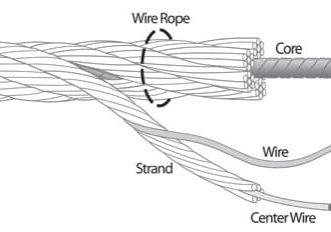On the Safety Factor of Suspension Ropes
Jul 1, 2015

A suggestion is made to clarify an important clause in the EN 81-20:2014 standard.
by Yongqiang Shen, Junhua Shen, Rongfeng Lu, Qun Chen and Jun Ye
Suspension ropes are important lift components; therefore, EN 81-20:2014 Safety Rules for the Construction and Installation of Lifts for the Transport of Persons and Goods — Part 20: Passenger and Goods Passenger Lifts defines many requirements for suspension ropes, including the definition of safety factor. However, safety factor may likely be less than the minimum value specified in EN 81-20:2014 Clause 5.5.2.2 when the car isn’t stationary at the lowest landing, although the safety factor satisfies the requirements in EN 81-20:2014.
EN 81-20:2014 defines safety factor as “the ratio between the minimum breaking load, in Newtons, of one rope and the maximum force, in Newtons, in this rope, when the car is stationary at the lowest landing, with its rated load.” However, the safety factor is the ratio between the invalid stress to the maximum designed force of material or component. In general conditions, the force in one suspension rope is the maximum value when the car is stationary at the lowest landing with its rated load. Therefore, it is suitable to calculate the safety factor of suspension ropes according to the definition. But, in some lift designs, the force in one suspension rope isn’t the maximum value when the car is stationary at the lowest landing with its rated load. When the car is stationary at another position with its rated load, the safety factor of the suspension ropes may be less than the value calculated according to the definition. Therefore, in those conditions, it is unsuitable to calculate the safety factor of suspension ropes according to the definition. A lift design as shown in Figure 1 is an example of analysis of the safety factor of suspension ropes.
Safety Factor Evaluation
When Car Is Stationary at the Lowest Landing with Its Rated Load
Mass of suspension ropes on the car side is:

According to the given parameter in Figure 1 and Table 1, the value of angle α is:

The force in one suspension rope on the car side is:

Therefore, the safety factor is:

When Car Is Stationary at Another Position (Such as the Highest Landing) with Its Rated Load
Compensating rope mass is:

Traveling cable mass is:

According to the given parameter in Figure 1, the value of angle α is:

The force in one suspension rope on the car side is:
Therefore, the safety factor is:

Conclusion
The force in one suspension rope in the vertical direction is changed little when the car is stationary at the highest or lowest landing with its rated load. But, the force of one suspension rope and the safety factor varies greatly, because the value of angle α is varied when the car is stationary at the different position. The safety factor will be correspondingly reduced, as the value of angle α is reduced.
In that condition or similar conditions, the safety factor may likely be less than the minimum value specified in EN 81-20:2014 Clause 5.5.2.2 when the car isn’t stationary at the lowest landing, although the safety factor satisfies the requirements in EN 81-20:2014.
Therefore, your authors suggest that the definition of the safety factor in EN 81-20:2014 Clause 5.5.2.2 be changed to “The safety factor is the ratio between the minimum breaking load, in Newtons, of one rope and the maximum force, in Newtons, in this rope, when the car is stationary at the worst position with its rated load.”

References
[1] British Standards. EN 81-20:2014 Safety Rules for the Construction and Installation of Lifts for the Transport of Persons and Goods — Part 20: Passenger and Goods Passenger Lifts (2014).
Get more of Elevator World. Sign up for our free e-newsletter.










